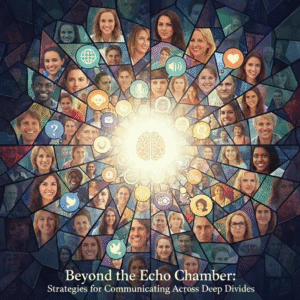 Reclaim Your Focus, Without the Guilt! Last time, I shared my thoughts about embracing the buzz while navigating life’s busy patches, and the power of great communication at these times. If you missed it, you can catch up here
Reclaim Your Focus, Without the Guilt! Last time, I shared my thoughts about embracing the buzz while navigating life’s busy patches, and the power of great communication at these times. If you missed it, you can catch up here
In today’s hyper-connected professional world, the ping of a new email, the flash of a message, or the ringing of a phone can feel like an omnipresent hum. For dedicated, busy professionals striving for impact, this constant connectivity often presents a challenging paradox: how do you remain accessible and collaborative without sacrificing the deep focus required for high-quality, strategic work?
The truth is that many of us are struggling. We fear that setting boundaries might label us as uncooperative, unresponsive, or worse, disengaged.
We worry about missing crucial information or letting down our team. Yet, the relentless stream of interruptions fragments our attention, erodes our productivity, and often leaves us feeling perpetually behind, rather than truly impactful.
The Hidden Cost of Constant Availability
Being “always on” isn’t a badge of honour; it’s a drain on your most valuable resource: your cognitive energy. Each interruption, even a brief one, can take significant time to recover from, pulling you away from complex problem-solving or creative thinking. This constant context-switching leads to:
- Decreased Quality of Work: Rushed responses and fragmented attention rarely lead to your best output.
- Increased Stress and Burnout: The feeling of being perpetually reactive can be exhausting.
- Reduced Strategic Thinking: It’s difficult to see the bigger picture when you’re constantly putting out small fires.
- Diminished Impact: When your focus is diluted, so is your ability to drive significant results.
“Easier Said Than Done,” Right? Addressing Your Inner Critic.
You might be reading this and thinking, “That all sounds great in theory, but my reality is different.” I hear you and you’re right to be sceptical. The common objections are powerful:
- “My boss expects instant replies.”
- “My clients demand constant accessibility.”
- “What if there’s an emergency I miss?”
- “Everyone else is always online; I’ll look like I’m not pulling my weight.”
- “I just feel guilty not responding immediately.”
These aren’t just excuses; they’re legitimate concerns rooted in workplace culture and professional expectations. Yes, here’s the critical insight:
Setting boundaries isn’t about disappearing; it’s about communicating smarter to enhance your impact, not diminish it.
Shifting Your Mindset: Boundaries as a Professional Asset
The key to regaining control isn’t to shut off completely, but to communicate intentionally. Think of communication boundaries not as barriers, rather as intelligent frameworks that enhance collaboration and respect. When you manage your availability, you’re not just protecting your time; you’re demonstrating:
- Professionalism: You value your time and the quality of your work, leading to better outcomes.
- Respect for Others: Clear boundaries mean others know when and how best to engage with you, leading to more efficient, less frustrated interactions.
- Leadership: You’re modelling effective work habits and focus for your team and peers.
- Improved Responsiveness (when it matters): By reducing constant interruptions, you’re more present and effective when you are
Crafting Your Communication Framework: Practical Steps, Not Just Theory
So, how do you begin to reclaim your focus without alienating colleagues or clients, and without missing critical information? It starts with a few foundational, actionable principles:
- Define Your Deep Work Blocks (and Protect Them): Identify specific, non-negotiable times when you need uninterrupted focus. Start small – even 60-90 minutes a day can make a huge difference. During these times, turn off notifications, close unnecessary tabs, and let your team know you’re in “focus mode.”
- Communicate Your Intentions Proactively and Transparently: This is crucial. Instead of just disappearing, inform your team, and where appropriate, key clients, about your communication strategy.
- Example Message: “To ensure I can dedicate focused attention to [project / task], I’ll be in a ‘deep work’ block from [Time] to [Time] daily. For urgent matters during this period, please [call my direct line/message me on specific channel] – otherwise, I’ll respond to emails / messages after [Time].”
- Establish Clear Channels for Urgency: For those “what if there’s an emergency” scenarios, ensure there’s a designated, agreed-upon method for critical contact. This might be a specific phone number for urgent calls, or a team chat channel explicitly for high-priority alerts. This provides peace of mind for everyone.
- Leverage Technology Wisely: Use “do not disturb” features on your phone and computer. Set up out-of-office replies for specific periods if needed or use email rules to filter less urgent messages. Schedule times to check and respond to emails / messages rather than reacting to every single one.
- Start Small, Iterate, and Be Patient: You don’t have to overhaul everything overnight. Begin with one deep work block a day or commit to not checking emails before a certain time. Observe the impact, adjust your approach, and communicate any changes. Overcoming years of “always on” conditioning takes time and consistent effort.
By proactively managing your communication, you move from a reactive state to a strategic one. You empower yourself to deliver higher quality work, think more clearly, and ultimately, make a far greater impact. It’s about working smarter, not just harder, and ensuring your professional buzz is productive, not just busy.
“People think focus means saying yes to the thing you’ve got to focus on. But that’s not what it means at all. It means saying no to the hundred other good ideas that there are.”
– Tim Cook –
[American Business Executive & CEO of Apple Inc.]
How do you currently manage your professional communication to stay focused, especially when the pressure is on? Share your top tips and challenges below!
With warmest wishes,

Korinne Le Page
Thrive Coaching & Training – Empowering You to Thrive!
Not yet subscribed to Thrive? Join here to receive weekly reflections and prompts: Subscribe to Thrive
P.S. Feel free to share your experiences and insights!
P.P.S. Book a complimentary Clarity Session with me here
#CommunicationSkills #ProfessionalDevelopment #Productivity #Leadership #WorkLifeBalance #ImpactfulCommunication #Boundaries

 Embrace Professional Buzz: Your Guide to Thriving
Embrace Professional Buzz: Your Guide to Thriving

 The Art of the Gentle Nudge – Influencing Action Without Force
The Art of the Gentle Nudge – Influencing Action Without Force What’s the one high-stakes conversation you’re currently avoiding (or wish you’d handled differently), and what’s the real cost of that silence?
What’s the one high-stakes conversation you’re currently avoiding (or wish you’d handled differently), and what’s the real cost of that silence?

 Thought for the Week – From Trust to Transformation: Is trust the soil where transformation takes root?”
Thought for the Week – From Trust to Transformation: Is trust the soil where transformation takes root?” 
